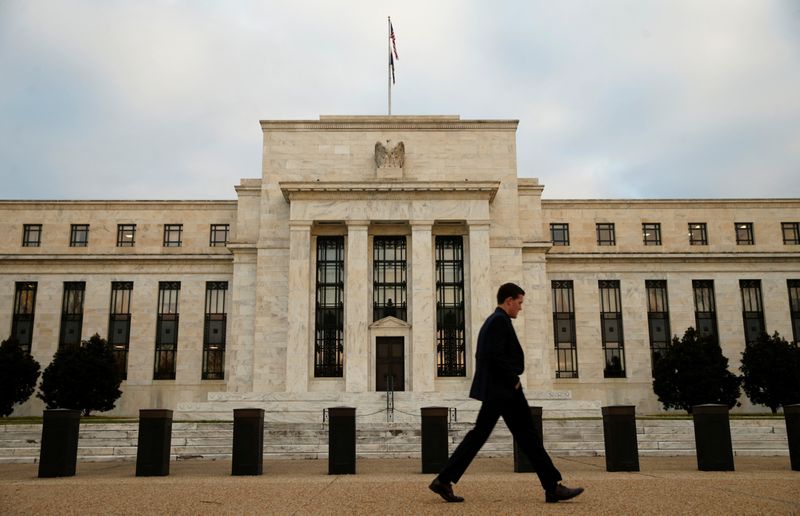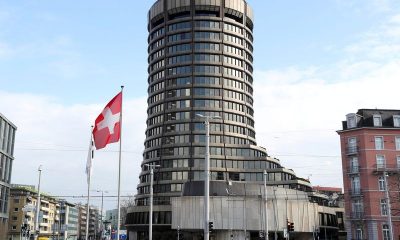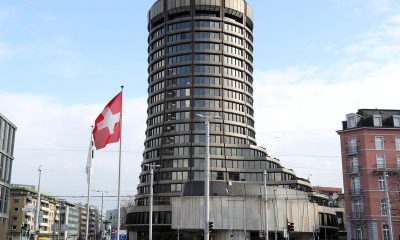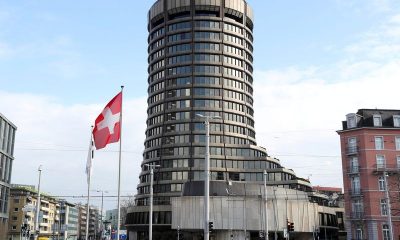Economy
Futures slip, central bankers, Nvidia hit by China curbs – what’s moving markets


© Reuters
Investing.com – Futures slip lower despite optimism over the U.S. economy as investors await commentary from central bankers. Oil prices push higher, while shares in Nvidia look set to lead declines in tech stocks after a report that Washington could restrict exports of artificial intelligence chips to China.
1. Futures slip lower
U.S. futures were broadly lower on Wednesday, as data pointing to strength in the U.S. economy was offset by caution ahead of an appearance by Federal Reserve Chair Jerome Powell later in the day which could provide cues on the path of interest rates.
A Wall Street Journal report that Washington was considering new restrictions on exports of artificial intelligence chips to China was also weighing on sentiment.
At 05:10 ET (09:10 GMT), the contract edged down 17 points, dipped 11 points or 0.2%, and were down 73 points or 0.5%.
The three main equity averages rebounded on Tuesday, with the tech-heavy leading the way, rising 1.6%. The blue-chip snapped a six-day losing streak while the rose after falling in five of the last six sessions.
Despite recent market weakness, a rally in growth stocks, an upbeat earnings season and bets that the Fed will soon end its monetary tightening mean the main indexes are on track for quarterly gains.
Ahead of the market open, earnings are due from packaged foods company General Mills (NYSE:) while Micron Technology (NASDAQ:) is due to report after the close.
2. Economic optimism
Data on Tuesday indicated that the U.S. economy remained on a solid footing despite fears over the prospect of a recession, but also indicated that the Fed will likely have to keep hiking .
Separate reports showed new orders for key U.S.-manufactured capital goods unexpectedly rose in May, and sales of surged last month, while U.S. rose to an almost one-and-a-half year high in June.
The U.S. central bank paused rate hikes earlier this month but indicated that two additional rate hikes were warranted this year.
The upbeat data prompted investors to narrow the odds on a July rate hike – traders are now a roughly 77% chance the Fed will raise interest rates by 25 basis points to the 5.25%-5.50% range in its July meeting, up from 74.4% a day earlier.
3. Central bankers
With central banks sticking to hawkish commentary on the interest rate outlook investors will be paying close attention to a panel discussion at the European Central Bank annual forum in Sintra, Portugal which includes Powell, as well as ECB President Christine Lagarde and Bank of Japan Governor Kazuo Ueda.
Hawkish comments by Powell last week stalled a rally on Wall Street that had pushed the S&P 500 and Nasdaq to an over one-year high and the Dow to a six-month peak.
Lagarde said on Tuesday stubbornly high inflation will require the bank to avoid declaring an end to .
Diverging monetary policy has pushed the yen to an almost 15-year trough against the and an eight-month low against the , giving rise to expectations that Japan could intervene in foreign exchange markets to stem the currency’s weakness.
When Japan intervened last October it knocked the dollar down from a top of 151.94 to as low as 144.50 in a matter of hours.
4. Oil prices rise
Oil prices moved higher Wednesday after data overnight showed a larger-than-expected drop in U.S. inventories, indicating that the demand outlook remained solid.
Crude stocks fell by about 2.4 million barrels, according to a from industry group American Petroleum Institute (API).
The Energy Information Administration’s official supply report is due out at 10:30 ET (14:30 GMT).
was up 58 cents, or 0.8%, to $73.09 a barrel at 05:10 ET (09:10 GMT), while West Texas Intermediate (WTI) rose 61 cents, or 0.9%, to trade at $68.28.
Brent is down about 15% this year as rising interest rates hit investor appetite, while China’s economic recovery has faltered after several months of softer-than-expected consumption and other data.
However, some analysts expect the market to tighten in the second half of the year because of ongoing OPEC+ supply cuts and Saudi Arabia’s voluntary reduction for July.
5. Nvidia hit by reports of China export curbs
Shares in Shares of NVIDIA Corporation (NASDAQ:) fell more than 4% ahead of the open on Wednesday after the Wall Street Journal reported that Washington is considering on exports of artificial intelligence chips to China.
Shares in rival chipmakers Advanced Micro Devices (NASDAQ:) and Micron were down 3.5% and 1.6%, respectively in premarket trade.
The Commerce Department will stop the shipments of chips made by Nvidia and other chip companies to customers in China as early as July, the report said. Nvidia gets about a fifth of its revenue from China.
U.S. chipmakers are caught in the crossfire between China and the Biden administration as Washington tries to curb Beijing’s technological advances.
Economy
Russian central bank says it needs months to make sure CPI falling before rate cuts -RBC


© Reuters. Russian Central Bank Governor Elvira Nabiullina attends a news conference in Moscow, Russia June 14, 2019. REUTERS/Shamil Zhumatov/File Photo
MOSCOW (Reuters) – Russia’s central bank will need two to three months to make sure that inflation is steadily declining before taking any decision on interest rate cuts, the bank’s governor Elvira Nabiullina told RBC media on Sunday.
The central bank raised its key interest rate by 100 basis points to 16% earlier in December, hiking for the fifth consecutive meeting in response to stubborn inflation, and suggested that its tightening cycle was nearly over.
Nabiullina said it was not yet clear when exactly the regulator would start cutting rates, however.
“We really need to make sure that inflation is steadily decreasing, that these are not one-off factors that can affect the rate of price growth in a particular month,” she said.
Nabiullina said the bank was taking into account a wide range of indicators but primarily those that “characterize the stability of inflation”.
“This will take two or three months or more – it depends on how much the wide range of indicators that characterize sustainable inflation declines,” she said.
The bank will next convene to set its benchmark rate on Feb. 16.
The governor also said the bank should have started monetary policy tightening earlier than in July, when it embarked on the rate-hiking cycle.
Economy
China identifies second set of projects in $140 billion spending plan


© Reuters. FILE PHOTO: Workers walk past an under-construction area with completed office towers in the background, in Shenzhen’s Qianhai new district, Guangdong province, China August 25, 2023. REUTERS/David Kirton/File Photo
SHANGHAI (Reuters) – China’s top planning body said on Saturday it had identified a second batch of public investment projects, including flood control and disaster relief programmes, under a bond issuance and investment plan announced in October to boost the economy.
With the latest tranche, China has now earmarked more than 800 billion yuan of its 1 trillion yuan ($140 billion) in additional government bond issuance in the fourth quarter, as it focuses on fiscal steps to shore up the flagging economy.
The National Development and Reform Commission (NDRC) said in a statement on Saturday it had identified 9,600 projects with planned investment of more than 560 billion yuan.
China’s economy, the world’s second largest, is struggling to regain its footing post-COVID-19 as policymakers grapple with tepid consumer demand, weak exports, falling foreign investment and a deepening real estate crisis.
The 1 trillion yuan in additional bond issuance will widen China’s 2023 budget deficit ratio to around 3.8 percent from 3 percent, the state-run Xinhua news agency has said.
“Construction of the projects will improve China’s flood control system, emergency response mechanism and disaster relief capabilities, and better protect people’s lives and property, so it is very significant,” the NDRC said.
The agency said it will coordinate with other government bodies to make sure that funds are allocated speedily for investment and that high standards of quality are maintained in project construction.
($1 = 7.1315 renminbi)
Economy
Russian central bank says it needs months to make sure CPI falling before rate cuts -RBC


© Reuters. Russian Central Bank Governor Elvira Nabiullina attends a news conference in Moscow, Russia June 14, 2019. REUTERS/Shamil Zhumatov/File Photo
MOSCOW (Reuters) – Russia’s central bank will need two to three months to make sure that inflation is steadily declining before taking any decision on interest rate cuts, the bank’s governor Elvira Nabiullina told RBC media on Sunday.
The central bank raised its key interest rate by 100 basis points to 16% earlier in December, hiking for the fifth consecutive meeting in response to stubborn inflation, and suggested that its tightening cycle was nearly over.
Nabiullina said it was not yet clear when exactly the regulator would start cutting rates, however.
“We really need to make sure that inflation is steadily decreasing, that these are not one-off factors that can affect the rate of price growth in a particular month,” she said.
Nabiullina said the bank was taking into account a wide range of indicators but primarily those that “characterize the stability of inflation”.
“This will take two or three months or more – it depends on how much the wide range of indicators that characterize sustainable inflation declines,” she said.
The bank will next convene to set its benchmark rate on Feb. 16.
The governor also said the bank should have started monetary policy tightening earlier than in July, when it embarked on the rate-hiking cycle.

 Forex3 years ago
Forex3 years agoForex Today: the dollar is gaining strength amid gloomy sentiment at the start of the Fed’s week

 Forex3 years ago
Forex3 years agoUnbiased review of Pocket Option broker

 Forex3 years ago
Forex3 years agoDollar to pound sterling exchange rate today: Pound plummeted to its lowest since 1985

 Forex3 years ago
Forex3 years agoHow is the Australian dollar doing today?

 Cryptocurrency3 years ago
Cryptocurrency3 years agoWhat happened in the crypto market – current events today

 World3 years ago
World3 years agoWhy are modern video games an art form?

 Commodities3 years ago
Commodities3 years agoCopper continues to fall in price on expectations of lower demand in China

 Economy3 years ago
Economy3 years agoCrude oil tankers double in price due to EU anti-Russian sanctions



























